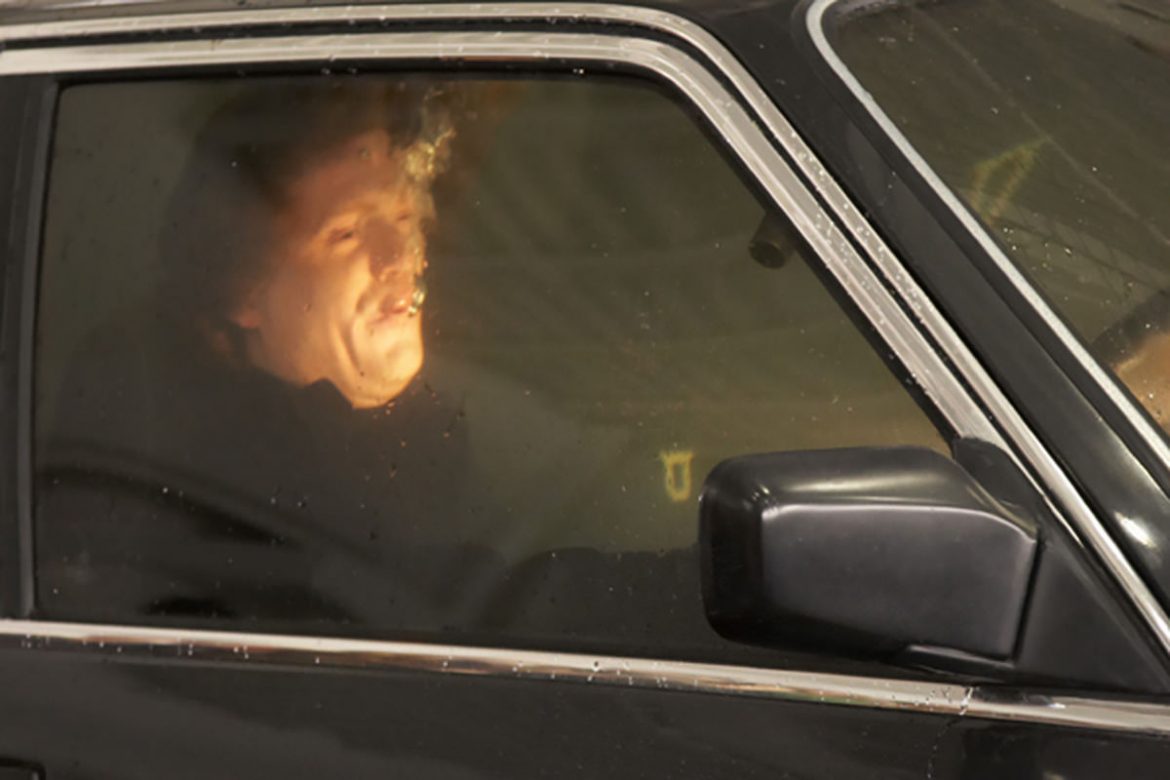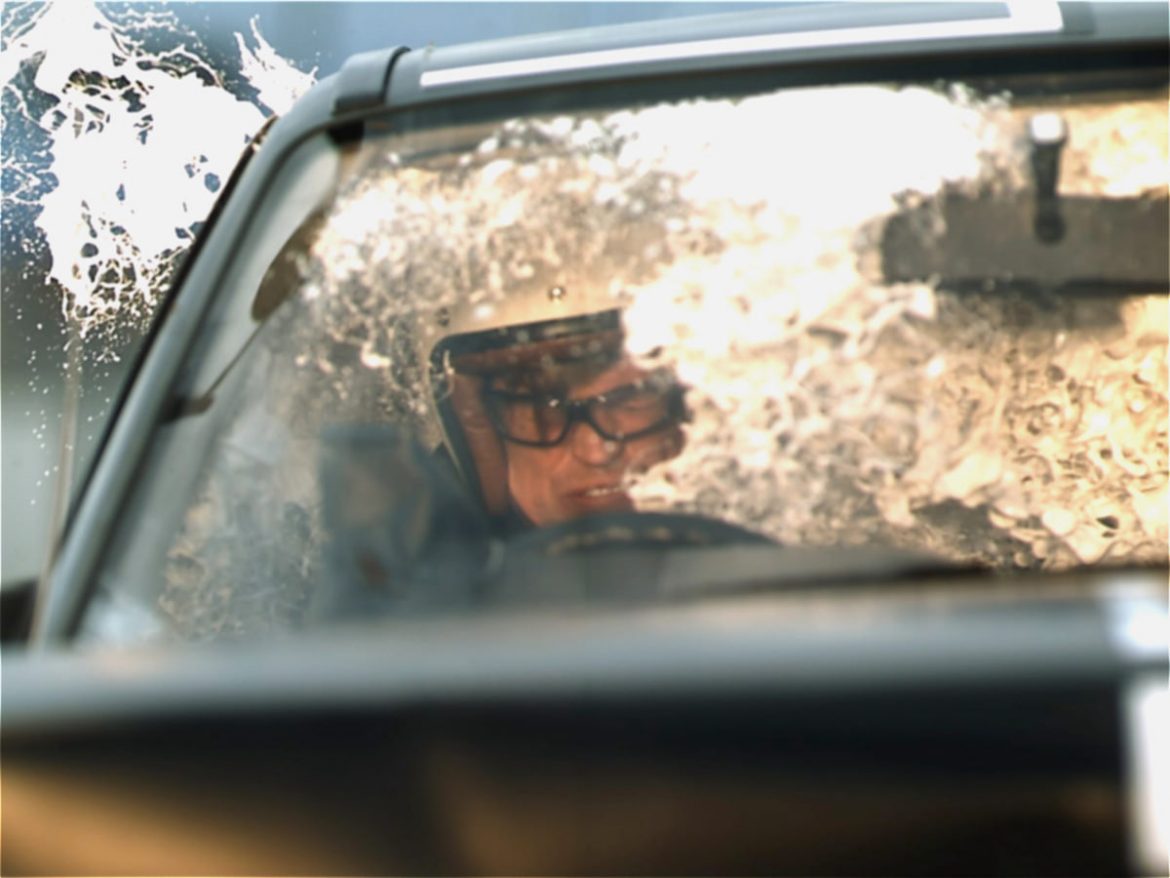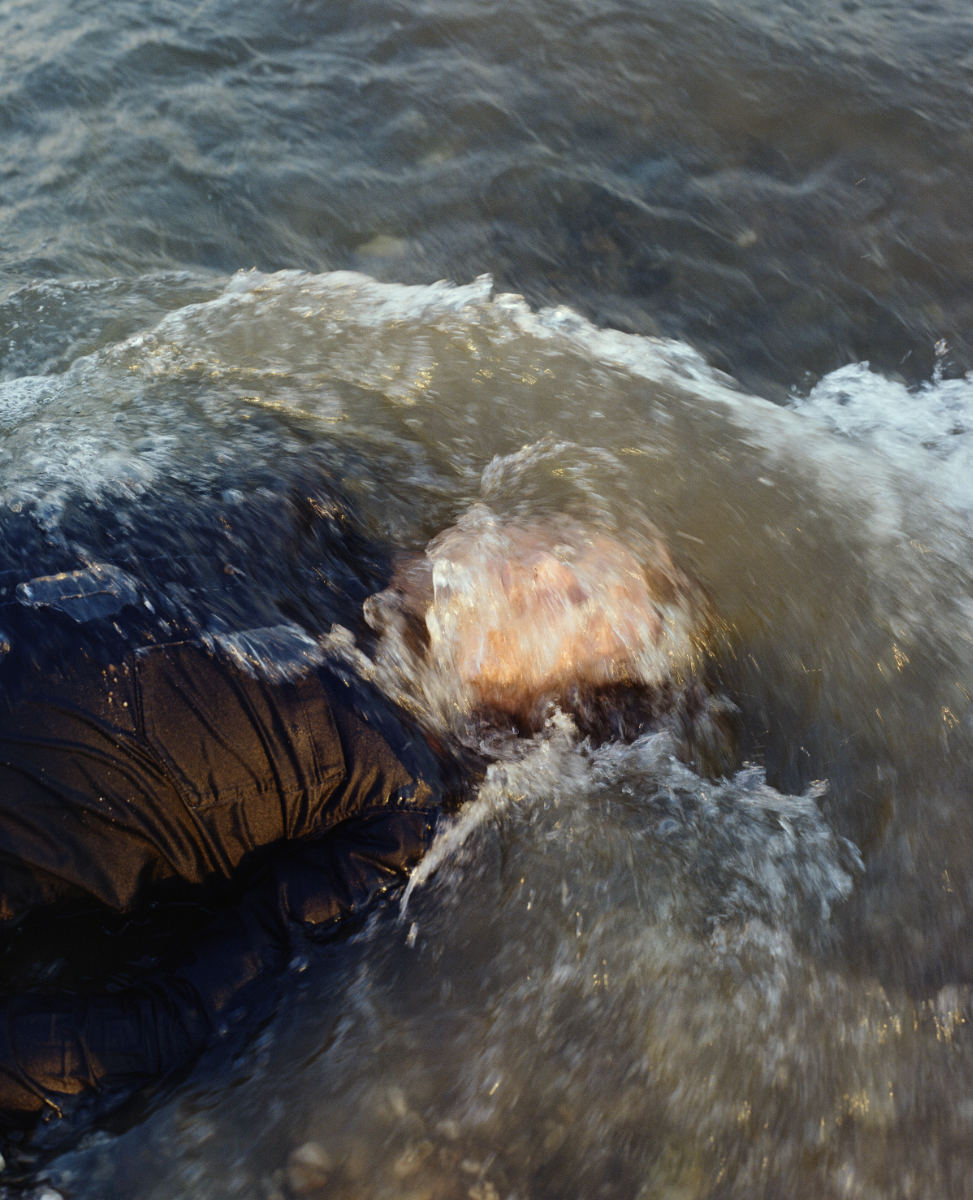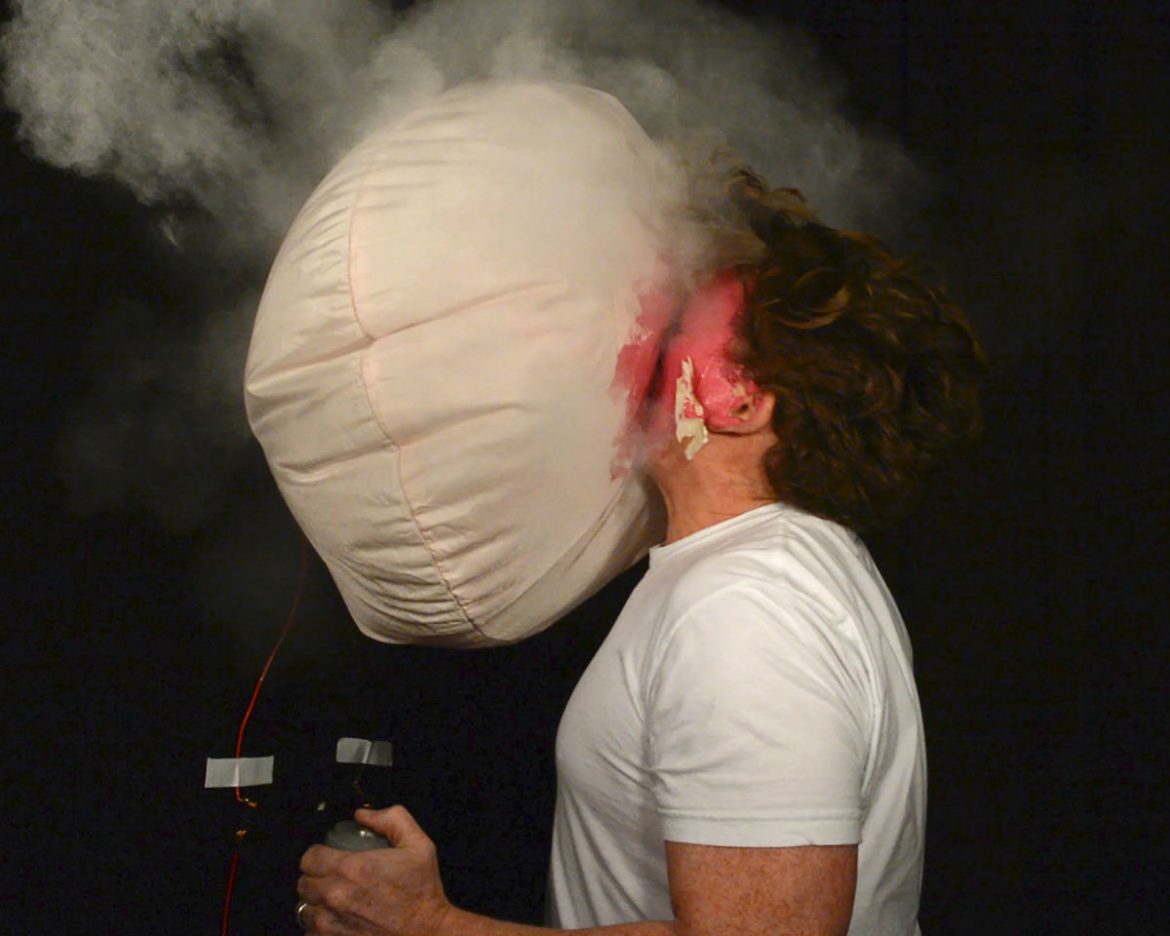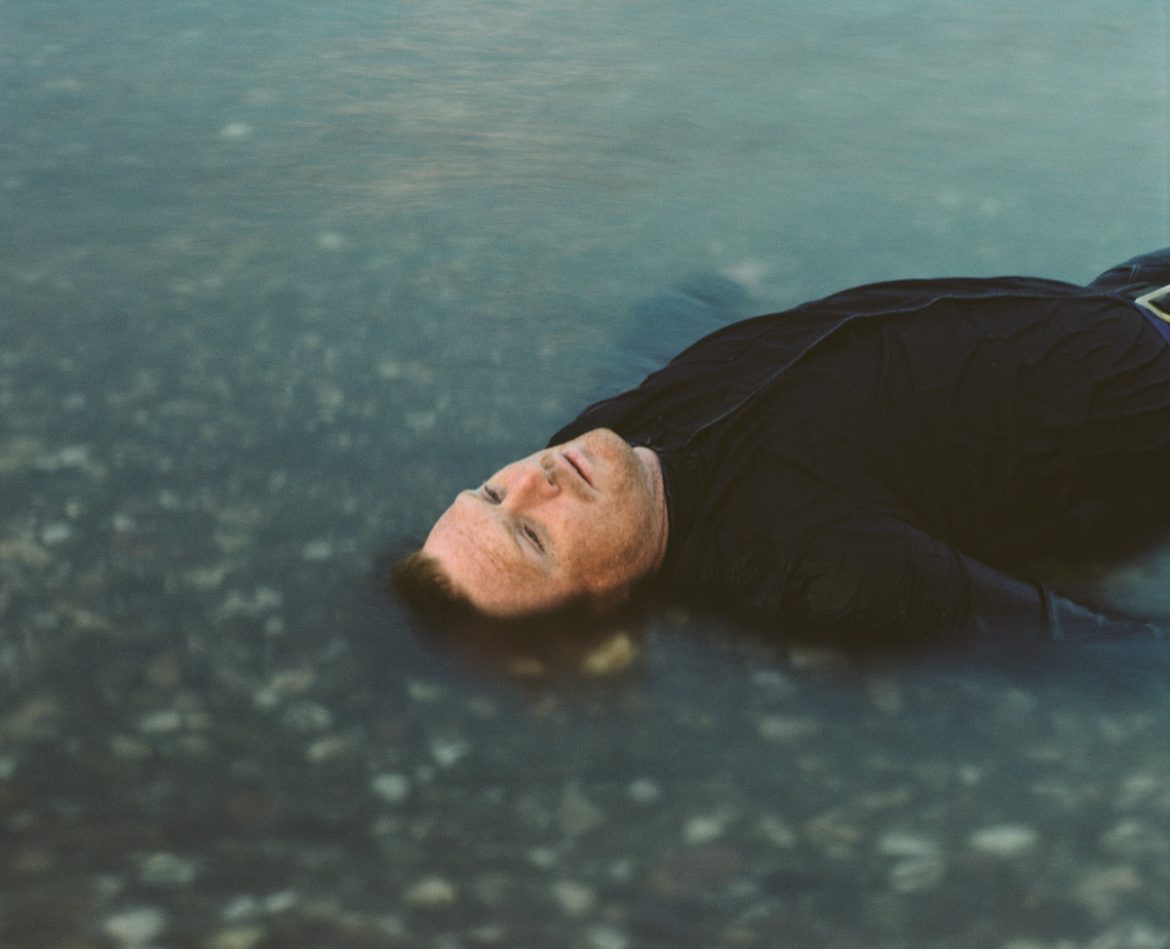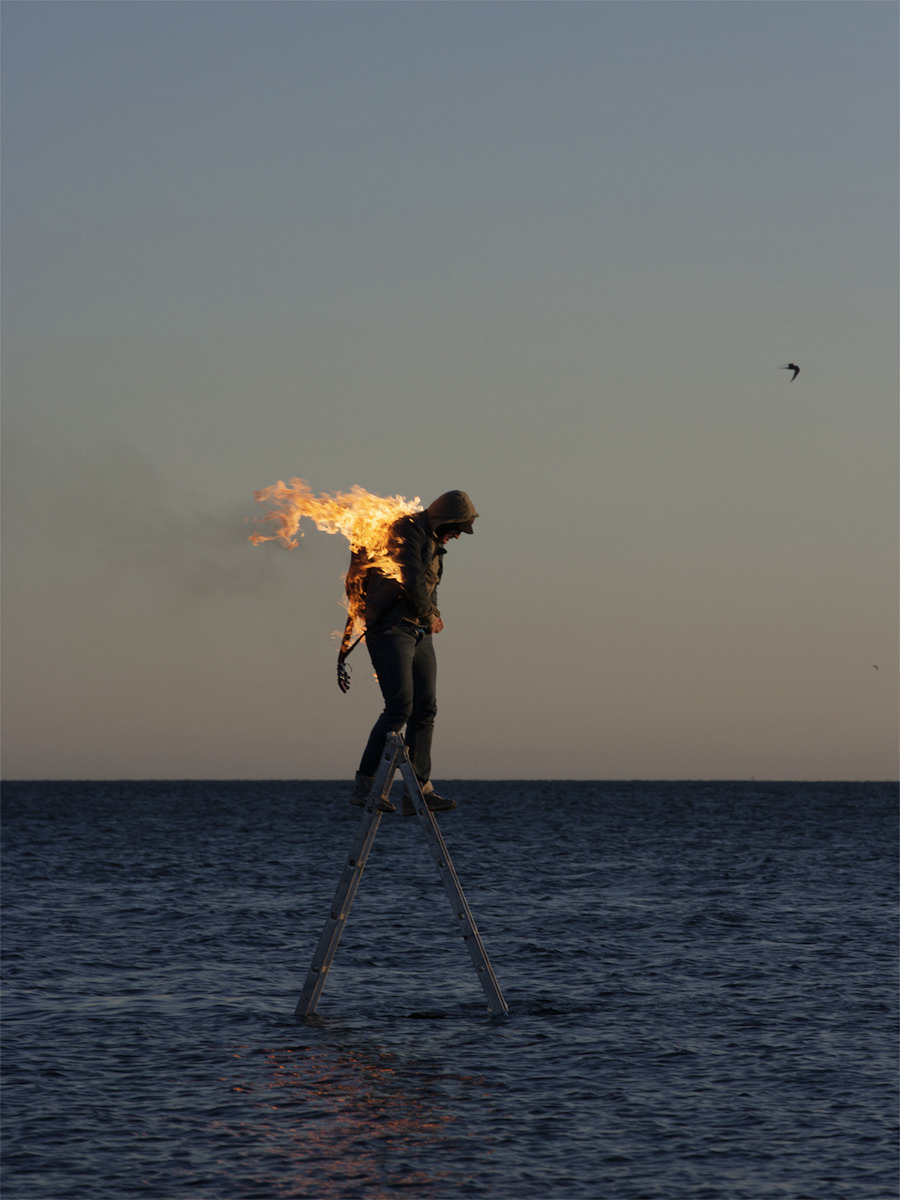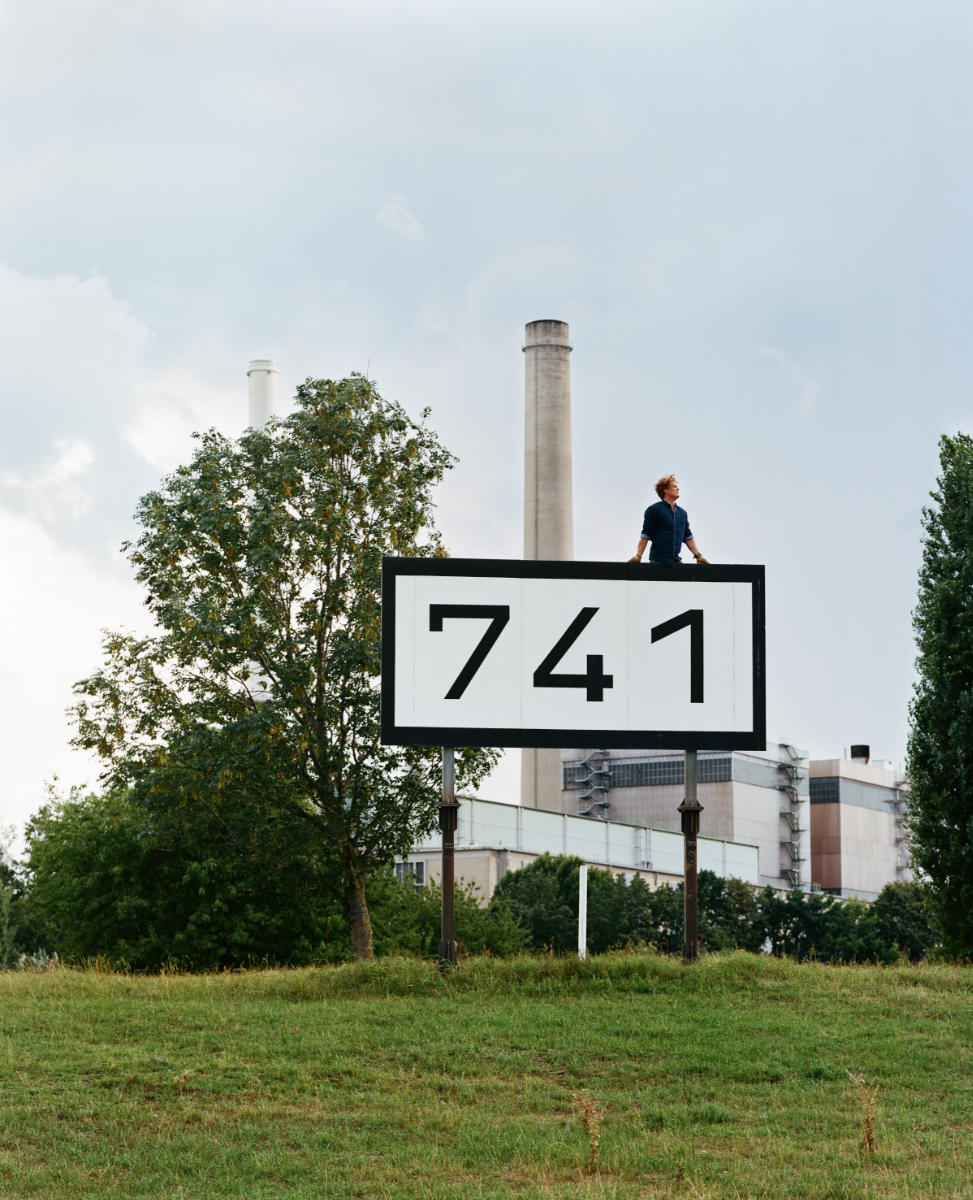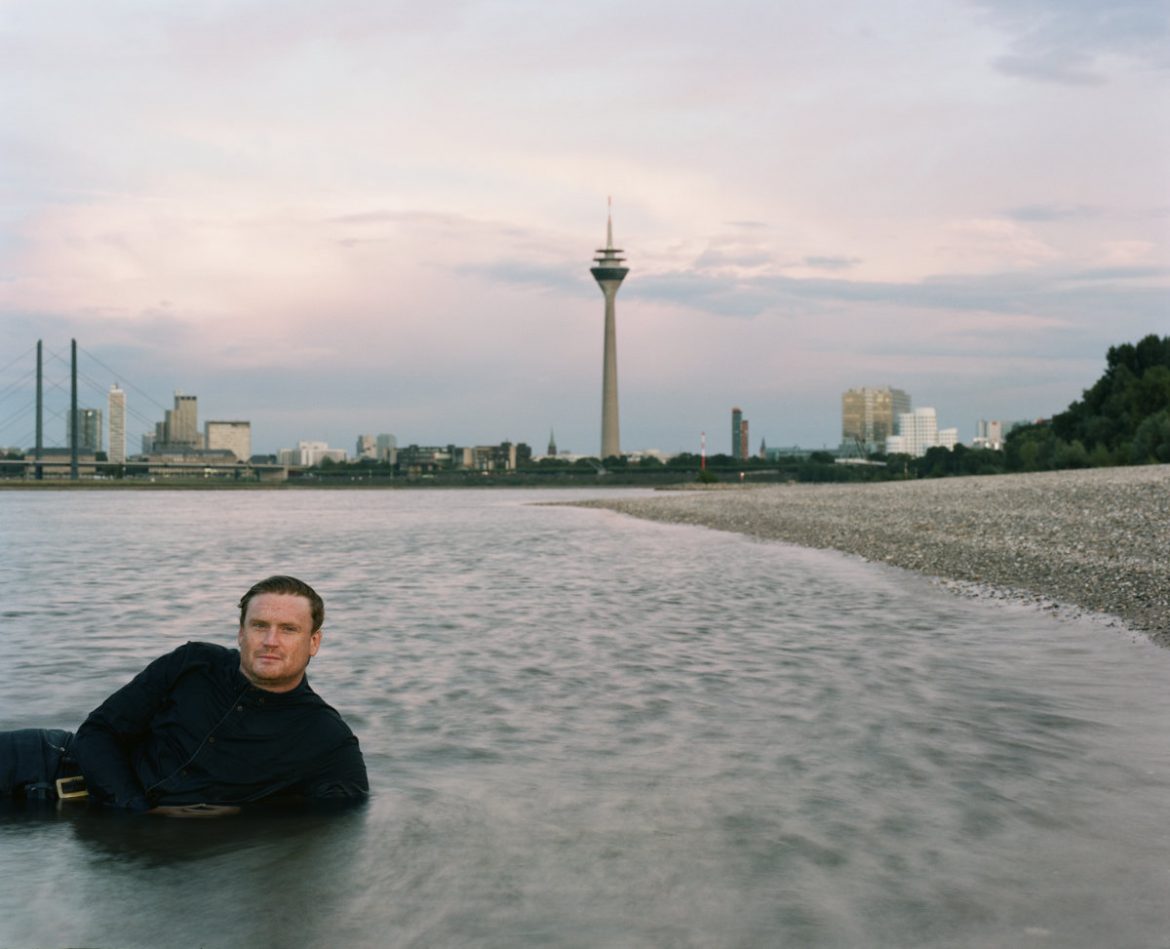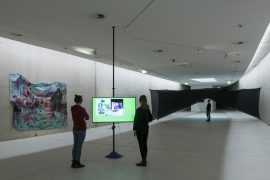Man stelle sich folgendes Szenario in Form eines Videos vor: Ein Mann fährt sein Auto mit hoher Geschwindigkeit gegen eine Betonbarriere. Jedes noch so kleine Detail des Crashs ist mitverfolgbar, denn mehrere Kameras halten das Geschehen aus unterschiedlichen Perspektiven fest. Im Moment des Aufpralls explodiert wie in Zeitlupe ein Behälter mit weißer Farbe auf dem Rücksitz des Fahrzeugs, wodurch der Mann am Steuer in eine milchig schimmernde Schicht eingehüllt wird. Wenige nervenaufreibende Momente später klettert er sichtlich aufgewühlt, aber körperlich unverletzt aus dem Autowrack und durchbricht die Stille mit einem ebenso tragisch wie absurd komisch anmutendem Lied.
>> Please scroll down for English version <<
Kein Zweifel, es ist ein ziemlich seltsamer Anblick, dessen Sinn man als Zuschauer unweigerlich hinterfragt: Was ist die Motivation des Mannes? Ist sein vorsätzliches und gezieltes Zufügen von psychischem und physischem Leid nur um des Singens willen? Oder gibt es in seiner musikalischen Performance eine tiefere Bedeutung als die der Grenzen durchbrechenden Leistung? Vielleicht erlangt der Song erst durch seine Assoziation mit dem Crash einen symbolischen Status: Kann es sein, dass wir, das Publikum, einer performativen Geste emotional mehr verbunden sind, wenn unser Blick gebannt auf ein beängstigendes Spektakel gerichtet ist? Auf der Suche nach Antworten haben wir den gewissen Jemand, der für das besagte Video verantwortlich ist, aufgespürt. Zu unserem Glück war er nicht sehr weit weg.
William Hunt ist ein Wahl-Düsseldorfer. Der in London geborene Künstler ist vor acht Jahren hierher gezogen, und hat nicht vor, die Stadt zu verlassen. In der Kunstwelt ist er vor allem für melancholische Musikauftritte in Extremsituationen bekannt, zum Beispiel unter Wasser, kopfüber von der Decke hängend oder unter dem Gewicht eines Klaviers zerquetscht – um nur ein paar Beispiele zu nennen. Wir wollten uns selbst ein Bild von diesem Künstler machen, und sprachen mit ihm bei einer Tasse Kaffee über seine Performances, die Face-to-face Beziehung zwischen Zuschauer und Darsteller, Körperpolitik und vieles mehr.
Wann wurde dein Interesse für Performance-Kunst geweckt? An der Kunstschule war ich in der Abteilung für Bildhauerei. Was die Produktion angeht, sind Skulpturen viel aufwendiger als andere Kunstformen wie beispielsweise die Malerei. Angenommen, jede Idee würde ein neues Medium benötigen, dann müsste man immer wieder aufs Neue das Atelier verlassen und sich auf Materialsuche begeben. Als jemand, der nicht gerade besonders organisiert ist, fand ich es recht anstrengend, einen Werkplan zu entwerfen und umzusetzen. Also begann ich mich mehr für den Schaffungsprozess als für das Endergebnis zu interessieren. In gewisser Weise tat ich das schon lange, denn bereits während meines Grundkurses verbrachte ich viel Zeit damit, in der freien Natur Dinge zu kreieren. Dieses erfahrungsorientierte Arbeiten hat es mir schließlich ermöglicht, den Inhalt meiner Werke durch das eigentliche Werkeln zu finden. An der Goldsmiths Universität hatte ich außerdem einen sehr guten Lehrer, der mir im Laufe meines Masterstudiums beibrachte, Selbstvertrauen in meine künstlerischen Arbeiten zu haben. Irgendwann ging es dann um die Frage, wie man eigentlich Performance-Kunst macht. Das Tolle war, dass ich keine vorgefasste Vorstellung von Künstlern hatte, die ich besonders mochte oder denen ich nacheifern wollte. Im Gegenteil: Es war für mich wie eine Tabula Rasa, die mir ermöglicht hat, meine eigene Stimme zu finden und zu entwickeln.
Wie definierst du Performance-Kunst? Ich glaube, es waren Marina Abramovic und Ulay, die gesagt haben, dass Performance-Kunst „realer Raum und reale Zeit“ ist – und zwar sowohl für das Publikum als auch für den Performer. Sprich: Alles, was für die Zuschauer passiert, passiert gleichermaßen für den Darsteller und umgekehrt. Es gibt kein Schauspiel, keine Heraufbeschwörung eines fiktiven Raums.
Wie unterscheidet sich Performance-Kunst von anderen konventionelleren Kunstpraktiken? Ich finde, dass alle Kunstpraktiken gleich behandelt werden sollten. Nehmen wir mal das Beispiel einer Vernissage: Wenn ein Künstler auf einer Ausstellungseröffnung fünf Gemälde präsentiert, an denen er fast zwei Jahre gearbeitet hat, dann würden die meisten Besucher seinen Zeitaufwand überhaupt nicht berücksichtigen. Ich aber setzte die malerische Geste mit der performativen Geste gleich. Allein das Maß an Engagement ist mir persönlich wichtig, um an einem Kunstwerk Gefallen zu finden.
Was Performance-Kunst aber andersartig macht, ist die verstärkte Ängstlichkeit des Publikums. Es geht immer darum, wie offen sich die Leute zu sein erlauben. Eine der Strategien, die ich anwende, um dem Publikum gegenüber großzügig zu sein, ist, im statischen Zustand zu performen. Denn ein Gemälde ist nicht beleidigt, wenn man auf halbem Wege wieder kehrt macht – genauso sollten auch (m)eine Performance rezipiert und behandelt werden. Nur wird Performance-Kunst in ihrer Form als radikal wahrgenommen, und deshalb sind unsere Häuser und Galerien voll von ruhigen Objekten. Das Problem mit Performance-Kunst ist, dass sie nicht auf dieselbe Art wie ein Gemälde mit einem Menschen zusammenleben kann. Daher dauert es viel länger, bis man sich mit ihr wohlfühlt.
In der Kunstwelt hast du dir mit musikalischen Performances unter Extrembedingungen einen Namen gemacht. Entspringen deine Ideen Impulsen jenseits des rationalen Denkens? Auf jeden Fall. Ich denke, Phantasie oder Vorstellungskraft sind wahrscheinlich die besten Wörter, die man hier verwenden kann. Wenn ich als Kind im Bett lag, habe ich oft meine Phantasie an die Decke projiziert, und so eine Welt heraufbeschworen, die nur optisch ist. Auf eine ähnliche Weise verschaffe ich mir auch ein geistiges Bild meiner Performances. Sobald ich eine verrückte Idee habe, stellt sich die Frage: Ist sie realisierbar? Anstatt den Ablauf von vorne bis hinten durchzuproben, entwickle und teste ich sehr simple Technologien wie zum Beispiel das kopfüber Hebesystem in meinem Stück „The Impotence of Radicalism In The Face of All These Extreme Positions”. Sobald ich ein Gefühl für meine Performance und einen emotionalen Kontext habe, in dem ich mich positionieren kann, erarbeite ich ein Musikstück, das diesen Ausdruck bestärkt und bereichert – sowohl geistig als auch körperlich. Ich versuche, meinem Körper zu erlauben, über sich selbst hinaus zu kommunizieren.
Deine Performances stehen in engem Zusammenhang mit der Idee des freien Falls. Warum testest du deine Fähigkeit, Gravitationskraft zu spüren und auszuüben? Ich finde die Newtonsche Physik wirklich beruhigend, was ihre Wirkung auf die Welt angeht. Und Naturkräfte sind äußerst interessant, weil sie unser aller Leben beeinflussen. Es ist großartig, sich mit elementaren Dingen wie der Schwerkraft zu beschäftigen, nicht nur, weil sie einem breiten Publikum vermittelbar sind, und sich jeder mit ihnen identifizieren kann, sondern auch wegen der Slapstick-Dynamik – egal ob Stolpern, Rutschen oder Stürzen: Unsere Bewegungen unterliegen den physikalischen Naturgesetzen, und es ist schön, sich bewusst zu machen, dass wir den Kräften der Welt ausgesetzt sind.
Deine Performances sind nicht zwingend masochistisch, aber sie spiegeln schon einen gewissen Leidenswunsch wider. Glaubst du, dass Darstellungen von Schmerz die Zuschauer daran hindern, die Narrative (d)einer Performance zu verstehen oder sie gar aufzulösen? Eine Kritik, die in letzter Zeit an mir geübt wurde, ist, dass meine Performances zu viel Schmerz zur Schau stellen. Aber für mich ist der Zustand des Bedroht-Seins ein Weg, die Aufmerksamkeit des Publikums zu bekommen und zu behalten. Es geht mir darum, die Menschen wachzurütteln und sie einander näher zu bringen. Ich rechtfertige das, was ich tue, wie folgt: Es gibt eine emotionale Erfahrung der Welt, eine kollektive Anstrengung, der ich mich verbunden fühle – ganz egal ob es um einen alten Mann geht, der viel Zeit braucht, um sein Ziel zu erreichen, oder um einen heldenhaften Bergsteiger: Die harte Arbeit, die Individuen leisten, und die emotionalen Kämpfe des menschlichen Lebens inspirieren mich dazu, nicht vor dem Aushalten zurückzuschrecken. Dabei geht es mir aber weder um aufgabenbezogene noch um zeitbasierte Wiederholung, denn ich möchte das Publikum mit Inhalten erreichen, die für jedermann konsumierbar sind. Was die von dir genannte narrative Auflösung betrifft, so denke ich, dass die besten Kunstwerke Zuschauern immer das Gefühl eines offenen Endes vermitteln. Menschen kommen nur dann zurück, um etwas erneut in den Augenschein zu nehmen, wenn sie es nicht vollständig verstehen.
Um was geht es dir bei deinen Performances? Deutest du auf Freude am Schmerz oder auf voyeuristisches Vergnügen hin? Nun, man könnte genauso gut fragen, warum die Leute damit einverstanden sind, zuzusehen, wie sich jemand in einem Galerieraum oder auf Youtube Schmerzen zufügt. Mit meinen Performances hinterfrage ich gerne die eigenen voyeuristischen Tendenzen des Publikums auf eine sanfte Art. In Wirklichkeit ist es aber eher eine „Check this shit out“-Situation. Ich fühle mich wohl dabei, in den Machtstrukturen zwischen Zuschauer und Darsteller eine tiefere Position einzunehmen, denn letztlich schneide ich besser ab. Für die Zuschauer mag es wie Unterwerfung aussehen, aber ich bin immer noch derjenige, der die Wahl trifft.
Im Jahr 1949 beobachtete der Psychoanalytiker Theodor Reik vier Komponenten des Masochismus: Phantasie, Spannung, Demonstration und Provokation. 1967 fügte der französische Philosoph Gilles Deleuze dem nochdie „vertraglichen Grundlagen“ der Beziehung zwischen Zuschauer und Darsteller hinzu. Würdest du aus der Perspektive dieser Theorie sagen, dass deinen Performances eine masochistische Logik zugrunde liegt? Das wurde ich schon oft gefragt. Nachdem ich mich mit diesem Thema gründlich befasst habe, bin ich zum Entschluss gekommen, dass all diese Texte ein einfaches, aber nicht konstruktives Argument verwenden – und zwar: Jedes Narrativ kann Elemente des Masochismus aufweisen, aber allein deshalb ist das Etikett nicht gerade eine vernünftige Widerspiegelung dessen, was der Künstler versucht zu vermitteln. Ich würde den von Reik und Deleuze angesprochenen Punkten zwar zustimmen, aber den Titel „Masochismus“ lehne ich ab. Vielleicht ist die Idee der Abweichung, des Opferseins, etwas interessanter…
Du hast gesagt, dass Performance-Kunst nicht mit Theater vergleichbar ist, weil sie „realer Raum und reale Zeit“ vor einem Publikum ist. Dennoch scheint deine Performance-Kunst eine narrative Struktur zu haben: Zuerst unterziehst du dich einer intensiven psychischen und physischen Herausforderung, und dann führst du ein etwas tragisch-komisches Lied auf – „from superman to everyman“, wie es die Kuratorin Ellen Mara De Watcher treffend formulierte. Meine Frage ist also folgende: Beruhen deine Performances teilweise auf Bühne und Erzählung oder stehen sie in ihrem direktem Gegensatz zu Theatralik? Das Schöne daran, Künstler zu sein, und Dinge in einem Museum oder einer Galerie zu inszenieren, ist, dass es keine Theater-Konventionen gibt: Keine Bühne, keine Sitzgelegenheiten, keine Beleuchtung, kein Vorhang – das ganze Drum und Dran ist beseitigt. Innerhalb der Performance hat man die Möglichkeit, so viel oder so wenig Gegenstände zu gebrauchen, wie man möchte. Wenn man sich dafür entscheidet, Requisiten miteinzubringen, werden sie auf eine tatsächliche und nicht auf eine theatralische Weise Teil der Inszenierung. Ein Ausstellungsraum ist nicht von Fiktion durchdrungen, daher erfordert Performance-Kunst eine andere Herangehensweise an den Schauplatz, seine Architektur und den breiteren Kontext.
In Aufführungen wie „You’re Gonna Pay For It Now. Now You’re Gonna Pay For It“ und „Still Yourself And Calm Your Boots“ sprichst du immer wieder eine Folge von scheinbar simplen Worten laut vor dich hin. Ist dein Mantra-Gesang eine Art mentale Trainingsstrategie oder versuchst du, das Publikum zu verzaubern? Ich hoffe, das Publikum, aber auch mich selbst verzaubern zu können. Einige Performances sind auf jeden Fall erfolgreicher als andere. Meine Lieder nehmen in der Tat die Rolle von Mantras ein, weil sie mir helfen, meinen Geist in einen anderen Kontext zu bringen, wenn ich eine schwierige Situation ertrage. Außerdem ist es für mich interessant zu sehen, wie sich Sprache verschiebt und verändert, je nachdem, was mein Körper durchmacht. In letzter Zeit habe ich die Lieder sehr stark auf Gesänge reduziert, so dass die Interaktion zwischen mir, dem Darsteller, und den Zuschauern weniger aggressiv ist.
In „A Moment’s Hesitation“ (2012) sagst du, dass du beim Betreten eines Performance-Space „kein Vater oder Ehemann“, sondern „William Hunt der Performer“ bist. Wie erreichst du diesen Geisteszustand? Um mit anderen Künstlern Schritt zu halten, und sich am kulturellen Gespräch zu beteiligen, muss man engagiert sein. Das Energielevel und die psychologische Verfassung sind mal so und mal so, aber letztlich geht es doch darum, wie man sich selbst herausfordernde, aber realistische Maßstäbe setzt, die einen bis zum Äußersten fordern. Allerdings möchte ich nicht Grenzen nur um der Grenzen willen testen. Es ist um der Kunst willen.
Deine Live-Performances entwickeln sich meistens zu skulpturalen, fotografischen oder videografischen Endergebnissen. Würdest du sagen, dass die Dokumentation von Performance-Kunst das Versprechen ihrer eigenen Ontologie verrät? Ja und nein. Ich habe das Filmemachen immer gemocht, aber natürlich sind Performances besser, wenn sie nicht aufgezeichnet werden. Denn Kameras bringen Zuschauer dazu, ihr Verhalten zu überprüfen. Es ist eine andere Art von Situation, wenn ich keine Kameras während der Performance verwende: Das Publikum ist in seinen Emotionen engagierter, und weil alle meine mentalen Fähigkeiten erhöht sind, nehme ich die Schwingungen des Raumes besser auf – sei es unbewusst oder bewusst. Wenn ich meine Performances nicht im Vorfeld aufnehmen oder aufzeichnen kann, setze ich die Kamera bewusst als Requisit ein. Im Fall von „You’re Gonna Pay For It Now. Now You’re Gonna Pay For It“ war die Kamera zum Beispiel ein ästhetisches Mittel, mit dem ich das Publikum in die Atmosphäre einer Live-Sitcom befördern wollte.
Performance-Künstler benutzen ihren Körper als Medium. Ist der menschliche Körper deiner Meinung nach von Natur aus politisch, und wenn ja, ist Performance-Kunst immer eine Form der politischen Praxis? Politisch mit einem kleinen ‚p‘, nicht parteipolitisch – ja, absolut: Performance-Kunst ist ein politischer Raum. In meiner Praxis gibt es einen politischen Unterton, weil ich mich an bestimmten Argumenten orientiere und versuche, auf bestimmte Anliegen aufmerksam zu machen. Außerdem werden meine Performances oft mit der Ästhetik von Emotion in Verbindung gebracht, und das geht nahtlos in Expressionismus und Körperpolitik über. Aber allein die einfache Tatsache, dass ich damit durchkomme, nicht politisch zu wirken, ist an sich schon politisch, weil ich ein Mann bin und die (Kunst-)Welt ein Patriarchat ist.
Was denkst du über den sich verändernden Status der Performance-Kunst? Was sich dramatisch verändert hat, ist, dass Performance-Kunst jetzt in Galerien, Museen und auf Kunstmessen konsumierbar ist. Diese Kommodifizierung der Performance-Kunst hat meinen Weg definitiv gestört und verändert. Es fühlt sich an, als ob die DIY-Punk-Ästhetik zum Stillstand gekommen ist, oder zumindest bekomme ich sie nicht mehr so richtig mit. Heute ist Politisierung ziemlich zum Mainstream geworden, und die vermittelnde Stimme hat eine viel stärkere Agenda. Der Grund, warum ich immer noch Performance-Kunst mache, ist, dass es in ihr eine Methodik und Direktheit gibt, die andere Formen der Kommunikation und des Ausdrucks nicht besitzen.
Welche Performance-Künstler hatten oder haben einen Einfluss auf deine Praxis? Das Knifflige an dieser Frage ist, dass Künstler mich nicht unbedingt durch ihre Arbeit beeinflussen. Es kann etwas sein, das sie geschrieben oder gesagt haben, das mich inspiriert. Das Tolle an Worten ist, dass sie nicht in direkter Konkurrenz zu einem selbst stehen. An der Kunstschule hat mir mein Lehrer Stuart Brisley zum Beispiel ein großartiges Buch mit dem Titel „The Encyclopedia of Stupidity“ gezeigt; das habe ich verschlungen. Brisley war ein eloquenter Mann, der sehr gut darin war, Unsinn rational zu artikulieren. Was ich von ihm gelernt habe, ist, dass man den Schein von Kontrolle als künstlerisches Sprungbrett benutzen kann. Was andere Künstler angeht, so mochte ich Bas Jan Ader irgendwann einmal sehr gerne, aber irgendwie bin ich dann durch ihn hindurch und über ihn hinaus gewachsen. Ich habe mich auch von Carolee Schneemann inspirieren lassen, aber für mich ging es weniger um bestimmte Personen als vielmehr um die Verletzlichkeit und die daraus resultierende Stärke des menschlichen Körpers, wie er auf einem Schwarz-Weiß-Foto aus den 1960er Jahren zu sehen ist. Wenn ich mich für einen Künstler entscheiden müsste, dann würde ich Giacometti wählen, weil die Optik beim Betrachten seiner Skulpturen so performativ ist.
Du bist in London geboren und aufgewachsen, aber Düsseldorf ist deine Wahlheimat. Warum bist du hierher gekommen und was hat dich zum Bleiben bewogen? Meine Frau ist ursprünglich Düsseldorferin. Die wirtschaftliche Situation Londons wurde für unsere vierköpfige Familie schwierig, also haben wir nach anderen Möglichkeiten gesucht. Da wir in Düsseldorf Verwandte haben, war die Stadt ein guter Ort, um einen Neustart zu versuchen. Der Grund, warum wir geblieben sind, ist, dass es sowohl für uns als Familie als auch für die Karrieren meiner Frau und mir gut funktioniert hat. Abgesehen davon ist Düsseldorf auch eine echt tolle Stadt, die viel mehr bietet, als ihre Bevölkerungszahl den Anschein erweckt. Die Museen hier sind riesig und zeigen häufig spannende Wanderausstellungen, die um die ganze Welt reisen. Viele meiner internationalen Freunde kommen nach Düsseldorf, um sich Ausstellungen anzusehen. Es gibt eine unglaublich reiche Kulturszene – alles, was man sich in einem überschaubaren Rahmen wünschen kann. Ich hatte das Glück, eine Karriere in London aufzubauen und dann an einen Ort zu ziehen, der mir mehr Raum zum Arbeiten bietet.
Was vermisst du an London? Das nostalgische Gefühl von Heimat. Aber im Alltag vermisse ich eigentlich gar nicht viel.
Was schätzt du an Düsseldorf? Ich liebe den Rhein. Im Gegenteil zur Themse in London ist der Fluss nicht einfach ein hässliches altes Gewässer, das den Menschen in der Stadt die Chance zum Durchatmen bietet. Wenn man im Winter über eine Brücke gehen will, die den Rhein überquert, muss man sich fragen: Habe ich die richtige Kleidung an? Werde ich das wirklich tun? Es ist viel epischer.
Deine drei Worte, um Düsseldorf zu beschreiben, sind: Ich habe vier Worte: Es ist kein Dorf.
Dankeschön!
Text: Merit Zimmermann
Fotos: Sabrina Weniger & William Hunt
(c) THE DORF 2020/21
English version:
Face To Face: An Interview With British Artist William Hunt
Picture this: You’re watching a video of a man who is knowingly and intentionally driving a car into a concrete barrier at high speed. Imagine that the crash is captured from several camera angles simultaneously and played back in minute detail. At the moment of impact, a reservoir of white paint explodes from the backseat of the vehicle, covering the driver with a layer of muted colour in slow motion. A few nerve-wracking moments later, he emerges from the wreckage shaken, but unharmed, before breaking out of silence and into a song that’s as tragic as it’s absurd.
Suffice to say, it’s a pretty weird scene. But what’s the point of it all? Is the intentional infliction of psychological and physical distress simply for singing’s sake? Or are there larger meanings at stake in the musical performance? Perhaps the song is given an emblematic status through its framing: Could it be that we, as spellbound viewers, are more emotionally engaged with the performative gesture when faced with a frightening spectacle? In search of answers, we hunted down the certain someone responsible for the video that got us thinking. Lucky for us, he wasn’t very far away.
William Hunt is a Duesseldorfer-by-choice. The London-born artist moved here eight years ago and isn’t planning on leaving anytime soon. In the art world, he is best known for performing melancholic musical pieces under extreme conditions. Past works have seen him singing and playing; underwater, suspended upside-down from a ceiling and squashed by a piano. To find out what makes this artist tick, we met William Hunt over a cup of coffee and talked to him about his practice, face-to-face performer-audience relationships, body politics, and much more.
When did you first become interested in performance art? My background at art school was in the sculpture department. As an art form, sculpture is a more involved production process than, say, painting. If each idea wanted a new medium, you’d have to move out of the studio and back in with new materials. As someone who is not the most organised, I found it quite stressful to conceive and action the plan for what I wanted to create – so I became more interested in the working process than the end result. On my foundation course, I’d already spent a lot of time building things in the outdoors so in a sense this experiential way of working always resonated with me and eventually enabled me to find the content in the work through doing the work. During my masters at Goldsmiths, I had a very good tutor who taught me to have the confidence for my work to just be what it is. It then became a discussion about: How do you go about making a performance? What was great is that I didn’t have a preconceived concept of artists that I particularly liked or was trying to emulate. This tabula rasa allowed me to find and develop my own artistic voice.
How do you define performance art? I think it was Marina Abramovic and Ulay who said that performance is „real space and real time“ for both the audience and the performer, so basically what that means is: Everything that’s happening in front of the audience is also happening for the performer and vice versa. There’s no acting, no conjuring up of a fictional space.
How is performance art different from more conventional art practices? I don’t think performance does differ. I think that all art practices should be treated the same. Let’s say you’re at a private view and an artist is exhibiting five paintings that he’s spent nearly two years working on. Most people would ignore the decision to invest such a long period of time into something that seems so small. But I put the gesture of making art and making performance at the same level. For an artwork to resonate with me, there’s a level of personal commitment I always look for and really enjoy when I find. When artists lean into conventions, that allows for lazy thinking – no matter the art form. There’s always compromise, but it’s that thing of permission, what’s allowed and what’s not allowed. That can be very literal in terms of production or more metaphorical in terms of what’s being represented and whose voice is being heard. What makes performance different is that there is greater anxiety within the audience: How open are people allowing themselves to be? To be generous to the audience, one of the strategies that I employ is to often be static. A painting won’t get offended if you walk away halfway through – a performance should be received just the same. But because its form is viewed as radical, we sit with these quiet objects in galleries and our houses. The trouble with performance is that it can’t live alongside people in the same way as a painting, so it takes longer to become comfortable with it.
In the art world, you’ve made a name for yourself with musical performances under extreme conditions. Do your ideas issue from impulses beyond rational thought? Definitely. I think fantasy or imagination are probably the best words to use. As a kid, I’d lie in bed and project my imagination onto the ceiling, conjuring up a world that’s only optical, I likewise create a mental image of my performances. Once I have a bonkers idea, it’s a question of: Is it feasible? Rather than rehearse my performances, what I do is develop and test very rustic, basic technology such as the hoisting system in my upside-down piece “The Impotence of Radicalism In The Face of All These Extreme Positions”. When I have a feeling of a performance and an emotional context to work in, I develop a piece of music that is in tune with and adds another element to that expression; both mentally and physically. I try to allow my body to communicate beyond itself.
Your performances are strongly related to the notion of free fall. Why do you test your body’s resistance to changes in motion and its ability to feel and exert gravitational force? I find Newtonian physics really reassuring in terms of its effect on the world. Innate forces of nature like gravity are naturally interesting because they affect all of our lives. The great thing about engaging with such elemental things is not only that they can be communicated quite easily, everyone can relate, but also because of the dynamics of slapstick. Whether it’s a fall, a slip or a trip: We’re constantly subjected to physical laws of creation and it’s nice to remember that we’re at the mercy of the world.
Your performances aren’t per se masochistic but they do reflect some desire to suffer. Do you think that your representations of pain hinder viewers from comprehending and possibly resolving the narrative coherently? A criticism that’s been put to me recently is that I exhibit too much pain in my performances. But for me, the state of being imperilled is a way to get and to keep the audience’s attention. To wake them up and to bring them closer together. How I justify what I do and why I carry on doing it comes down to this: There’s an emotional experience of the world and a collective endeavour that I want to lie in sympathy with – whether it’s an old man walking slowly to reach his destination or a heroic mountain climber: The hard work that humans do and the emotional struggles inherent to human existence inspire me to not shy away from enduring. However, my performances don’t involve task-based repetition over sustained periods of time because I want to reach audiences with consumable content. As regards narrative resolution, I think that the best artworks always leave viewers feeling open. You only come back to ponder something when they don’t fully understand it.
What are the issues and meanings at stake in your performances? Do they suggest pleasure in being subjected to pain or voyeuristic pleasure? Well, why are people okay with watching someone inflict pain on themselves in a gallery space or on Youtube? With my performances, I like to question the audience’s own voyeuristic tendencies in a light way, when in reality it’s like ‚Check this shit out’. I feel comfortable placing myself down lower in the power structures between performer and audience because ultimately I’m springing higher. It might look like subjugation, but I’m still the one making the choice.
In 1949, psychoanalyst Theodor Reik observed four components to masochism: Fantasy, Suspense, Demonstration, and Provocation. In 1967, French philosopher Gilles Deleuze added to the mix the contractual underpinnings of the relationship between the viewer and performer. From the perspective of this theory, would you say a masochistic logic undergirds your performances? I’ve been asked this a lot. Having looked into this subject, for me, I think that all these texts use a simple but not constructive argument: All narratives can demonstrate elements of masochism but this label isn’t necessarily a reasonable reflection of the story itself. I would agree with the points raised by Reik and Deleuze but I’m going to reject the title of masochism. Perhaps there’s something more interesting about victimhood…
You’ve stated that performance isn’t comparable to theatre because it’s „real space and real time in front of an audience”; nevertheless there appears to be a narrative structure to your performance: First you undergo an intense psychological and physical challenge and then you perform a somewhat tragically comical song – “from superman to everyman” is how the curator Ellen Mara De Watcher aptly put it. So my question is this: Do your performances partially rest on theatricality, stage, and narrative or do they stand in direct opposition thereto? What’s great about being an artist and staging things in a museum or a gallery space is that there aren’t any theatrical conventions: No stage, no seating, no lighting, no curtain – all of the trappings are eliminated. In performance, you have the opportunity to engage with as much or as little as you like. When you choose to bring in props, they become part of the mise-en-scène in an actual, and not in a theatrical, way. An exhibition space is not steeped in fiction, so performance requires a different approach to the arena, its architecture, and broader context.
In performances like “You’re Gonna Pay For It Now. Now You’re Gonna Pay For It” and “Still Yourself And Calm Your Boots”, you repeatedly speak aloud a sequence of seemingly simple words. Is your mantra chanting a kind of mental training strategy or are you trying to enchant the audience? I hope to enchant the audience but also myself, some performances are definitely more successful than others. My songs indeed take the role of mantras because they help me to put my mind into a different context when enduring a difficult situation. Plus, it’s interesting for me to see how language shifts and changes depending on what my body is going through. Recently, I’ve reduced the songs very much to chants so that the performer-audience interaction becomes less aggressive.
In “A Moment’s Hesitation” (2012), you state that “you’re not a dad or a husband” but “William Hunt the performer” when entering a performance space. How do you get into this mindset? To keep up with other artists and to be engaged in the cultural conversation, you have to commit. Energy levels and psychological security go in waves but ultimately it’s a question of how to set challenging, yet realistic benchmarks that will push you to the n’th degree. But it’s not about pushing boundaries for the sake of boundary-pushing alone. It’s for the sake of art.
Your live actions usually lead to sculptural, photographic or video outcomes. Would you say that documenting performance betrays the promise of its own ontology? Yes and no. I’ve always liked filmmaking but of course, performances are better when they’re not recorded because cameras make audiences check their behaviour. It’s a different kind of situation when I don’t include cameras in the audience show: There’s a higher level of emotional interaction and, because all my faculties are heightened, I pick up on the vibe of the room – whether that’s subconsciously or consciously. If I don’t, or can’t, pre-record my performances, I knowingly use the camera as a prop, as was the case with “You’re Gonna Pay For It Now. Now You’re Gonna Pay For It”, which took on the aesthetic of a sitcom recorded live with a studio audience.
Performance artists use their bodies as a medium. In your opinion, is the human body itself inherently political and, if so, is performance art always a form of political practice? Political with a small ‚p’, not party politics – yes, absolutely: Performance is a political space. In my practice, there’s an undertone of politics because I align myself with certain arguments and try to bring awareness to particular concerns. Besides, my performances are often brought into connection with the aesthetics of emotion, which segue into Expressionism and body politics. But the simple fact that I can get away with not looking political is in itself political because I’m a man and the (art) world is a patriarchy.
What do you think of the changing status of performance art? What’s changed dramatically is that performance art is now consumable in galleries, museums and at art fairs. This commodification of performance has definitely disrupted and changed the path I’m on. It feels like the DIY punk aesthetic has come to a stop or at least I don’t see it as much. Today, politicisation has become quite mainstream and there’s much more of an agenda to the voice that’s being transmitted. The reason why I still choose to make performances is that there’s a methodology in it and a directness to it that supersedes many other modes of expression and communication.
What performance artists have had an impact on your practice? What’s tricky about this question is that artists don’t necessarily impact me through their work. It can be something they’ve written or said that inspires me and what’s so great about words is that they’re not in direct competition with you. For example, at art school my tutor Stuart Brisley introduced me to a great book called „The Encyclopedia of Stupidity“, which I read endlessly. He was a very well-spoken English man, who was great at articulating the nonsense of doing something without making it feel irrational. What I learned from him was that if you have some semblance of control and ownership, then your work can springboard a bit further. As regards to other artists, I liked Bas Jan Ader a lot at one point but have moved through and beyond him somehow. I also looked to Carolee Schneemann, but for me, it was less about specific people and more about the strength in vulnerability of a body as seen in a black and white photograph from the 1960s. Ultimately though, I’d go with Giacometti because the optics of looking at his sculptures are so performative.
You were born and raised in London but Düsseldorf is your home of choice. Why did you come here and what made you stay? My wife is originally a Düsseldorfer. London’s economic situation became tough for us with two children, so we looked at other options. With relatives here, Düsseldorf was a natural place to try. The reason we stayed is that it’s worked out well for both of us and our careers; besides, Düsseldorf is an amazing city that punches well above its population size. The museums are enormous and host exciting travelling shows that go around the world. A lot of my international friends come through Düsseldorf to exhibit. There’s an incredibly rich cultural scene – everything you could want on a manageable scale. I was very lucky to build a career in London and then move to somewhere that has allowed me more space to work.
What do you miss about London? The nostalgic sense of home. But on a day-to-day basis, I don’t miss very much at all.
What do you cherish about Düsseldorf? I love the Rhine. Unlike the Thames in London, it’s not just an ugly old river that offers people a breathing space in the city. To walk over a bridge that crosses the Rhine in winter, you have to ask yourself: Have I got the right clothes? Am I really going to do this? It’s much more of an epic thing.
Your three words to describe Düsseldorf are: I’ve got four words: It’s not a dorf’.
THE DORF • THE MAG is part of the #urbanana project by Tourismus NRW






